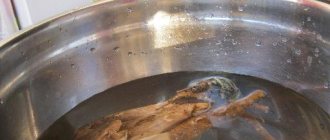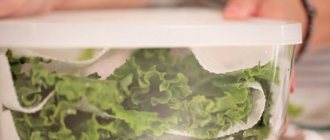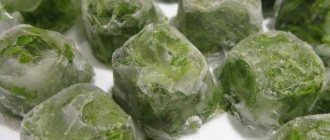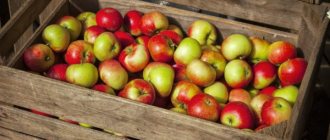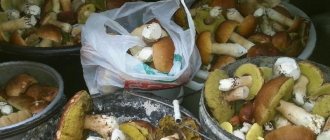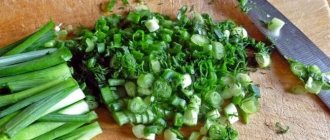AnyutaN — Oct 30th, 2021 Categories: Freezing
Tags: Frozen horseradish, Freezing vegetables
Horseradish root is used to prepare various hot sauces and cold appetizers, and horseradish leaves are used in home canning. The benefits of this plant are undeniable, so housewives often have the question: “Is it possible to freeze horseradish?” You will find out a detailed answer to this question by reading our article.
Ingredients: horseradish root, horseradish leaves, lemon juice, horseradish, apples Time for bookmarking: Summer, Autumn
Methods for freezing horseradish root
Before storing the product in the freezer, it must be thoroughly washed and cleaned with a knife. To better wash off the dirt, the rhizome can be soaked for a couple of hours in a large container of water.
Large rhizomes are convenient to clean with a vegetable peeler, while small and thin rhizomes are scraped off from dirt with the tip of a knife. Cleaning rhizomes is a long and not very pleasant task.
To eliminate contact of horseradish with air as much as possible, cleaned roots should be placed in a container with cool water. This will keep the aromatic substances of the plant intact.
After all the horseradish has been cleaned, you need to blot it with towels to remove excess moisture. Now you can start freezing!
Horseradish pieces
The cleaned rhizomes are cut into small pieces, 2–3 centimeters in length. The workpiece is placed in freezer bags or small containers. The tightly packed container is sent to the freezer for storage. If necessary, horseradish can be taken out and chopped in a meat grinder or blender without defrosting, and used for its intended purpose.
Watch the video from the channel “Know and be able” - How to preserve horseradish for the winter. The freezer will help you!
Grated horseradish
Horseradish can be chopped before placing in the freezer. To do this, use: a hand grater, a meat grinder or a blender.
The manual method of processing horseradish is very labor-intensive. At the same time, aromatic vapors corrode the eyes and prevent you from breathing freely. Therefore, to grind horseradish, it is better to use a manual or electric meat grinder or blender.
If you are using an electric meat grinder, then place a plastic bag over the outlet hole to maximally prevent the release of essential oils that cause burning and tearing of the eyes.
The “safest” way to chop horseradish is to cut it using a blender or food processor. Since the rhizome is very hard and dense, the power of the unit should be at least 600 - 700 W.
The Brovchenko family in their video will tell you how to clean and grate horseradish. Painless and tearless way.
Horseradish with apple and lemon juice
An excellent option for freezing horseradish immediately in the form of a sauce or snack. For example, you can freeze chopped horseradish root with grated apple. To do this, the products are taken in equal proportions and mixed with 1 teaspoon of lemon juice. This preparation can be frozen in ice cube trays or in a bag, spreading it out into a thin layer.
Read also: Preserving Daikon for the winter
After pre-freezing, horseradish cubes are removed from the molds and transferred to packaging bags or containers.
Contraindications and side effects
- The health benefits of horseradish are due to the presence of mustard oil in it. But this same component also causes possible harm to the product. For many people, allyl isothiocyanate causes severe irritation to the skin, mouth, throat, nose, digestive and urinary systems. Such hypersensitivity to mustard oil is a strict contraindication for the use of the root vegetable even in minimal quantities.
- Almost all young children react very strongly to the smell and taste of horseradish. Therefore, it is strictly forbidden to give vegetables to a child under 5 years of age. Moreover, even peeling fresh root vegetables in the presence of children is prohibited.
- Pregnant and breastfeeding women are also advised to avoid consuming Armoracia rusticana root.
- Horseradish is contraindicated for peptic ulcers of the digestive system. It should be used with great caution for any inflammation in the gastrointestinal tract.
- Kidney failure and decreased activity of the thyroid gland are also contraindications for the use of root vegetables.
These are compounds such as allyl isothiocyanate, 3-butenyl isothiocyanate, 2-propenyl glucosintate (sinigrin), 2-pentyl isothiocyanate and phenylethyl isothiocyanate, etc.
Thanks to the presence of these substances, horseradish root helps prevent cancer, protects against bacteria, strengthens the immune system and has an analgesic effect.
At the same time, medicinal compounds in the product may have an irritating effect on the mucous membranes of the respiratory, digestive and urinary systems. Therefore, you need to be careful with vegetables. Not all people can freely eat it.
Did you like the article? Share with your friends!
Did you like the post? Then subscribe to our channel in Yandex.Zen to always be aware of useful news from the world of proper nutrition.
Did you like the post? Then subscribe to our channel in Yandex.Zen to always be aware of useful news from the world of proper nutrition.
Are nutrients preserved when frozen?
Horseradish contains many vitamins (C, E, PP, group B) and minerals (iron, potassium, magnesium, calcium, phosphorus, sodium), which have a positive effect on the body, and essential oil, which gives the vegetable a special taste. When frozen, all beneficial substances are preserved. In addition, freezing will provide you with another pleasant “bonus” - the thawed root will no longer cause streams of tears during processing, while the taste and smell will be no worse than that of a fresh product.
Composition and beneficial properties
Horseradish is not an ordinary vegetable. Like other natural plant foods, it contains vitamins and minerals. So, 100 grams of root vegetables contain 42% of the daily requirement of vitamin C, 14% of folate, etc.
However, the vegetable has benefits. And the benefits are considerable. But it is explained by completely different biologically active compounds, which are included in its composition in small doses, but have a powerful effect on the body.
Anti-cancer and antioxidant activity
The medicinal properties of horseradish are due to the presence of glucosinolates in its composition, which are responsible for the unique aroma of the vegetable and give it anti-cancer properties. The concentration of glucosinolates in horseradish is so high that these compounds have a positive effect on humans even though the root vegetable is usually eaten in very small quantities.
In addition to glucosinolates, horseradish also contains many other antioxidants. Some of them not only destroy free radicals, but also prevent the appearance of mutations that arise in humans under the influence of unfavorable environmental conditions, taking medications and lead to the development of various degenerative diseases.
Antimicrobial properties
The oil responsible for the pungent taste of horseradish is called allyl isothiocyanate, or mustard oil. This oil is an antimicrobial agent that is active against a wide range of pathogenic microorganisms.
The antimicrobial properties of horseradish are associated not only with its effect on the pathogens themselves, but also with its effect on the human immune system. Armoracia rusticana root enhances the work of phagocytes - those cells of the immune system that absorb bacteria.
Treatment of colds
Since ancient times, traditional medicine has known about the medicinal properties of horseradish, which help destroy pathogenic bacteria. Therefore, the root of this plant is actively used to treat chronic bronchitis and runny nose.
A recent clinical study proved that horseradish extract helps cope with bronchitis and sinusitis as well as antibiotics. But it does not cause side effects and does not lead to the development of resistance in pathogens.
Moreover, Armoracia rusticana extracts enhance the separation of phlegm and mucus in the sinuses, helping to quickly rid the body of infection.
Treatment of urinary tract infections
This is one of the explanations why horseradish is good for women. It's no secret that the weaker half of humanity more often suffers from cystitis. And this vegetable helps to cope with this scourge. And again, without the use of antibiotics. Or, at least, reducing the amount of these heavy medications to a minimum.
Read also: Associated vaccine against myxomatosis and VHBK instructions
Allyl isothiocyanate (mustard oil) is excreted through the kidneys. Therefore, it perfectly disinfects the urinary system. Another component of horseradish, glycoside sinigrin, has diuretic activity. And thanks to this, it helps cleanse the kidneys and bladder.
Improved digestion
The benefits of horseradish for the human body are associated with its beneficial effect on the gastrointestinal tract. The root contains compounds that stimulate digestion, enhance intestinal motility and help avoid constipation. Vegetables are classified as choleretic products that facilitate the digestion of fatty foods.
Analgesic effect
Traditional medicine has used horseradish for centuries to relieve joint and muscle pain. Current scientific evidence suggests that Armoracia rusticana root may be useful in reducing pain associated with inflammation, such as arthritis or sports injuries.
How to freeze horseradish roots
There are several recipes for freezing horseradish for the winter. It can be stored either whole or in the form of pieces, grated, or immediately prepared as a seasoning.
Let's look at how to store horseradish for the winter in the freezer in the form of pieces.
- Before freezing the rhizomes, clean them well from the soil.
- Next, you need to rinse them well.
- Cut into pieces of several centimeters.
- Wrap in a plastic bag and place in the freezer.
- Grind the roots using a meat grinder or grater.
- Wrap in a plastic bag.
- Place in the freezer.
Read also: How to make a rose garden at your dacha with your own hands: basic rules for marking and planting flowers
It is better to use a blender, as the vapors that fresh vegetables emit are corrosive to the eyes and make it difficult to breathe.
Seasoning mix
You can keep horseradish fresh as a seasoning or sauce. One such method is the root recipe with apple and lemon juice.
- Apple and roots must be taken in equal quantities and mixed with a teaspoon of lemon juice.
- Next, freeze this mixture in molds or in a bag.
- If you are going to store it in a bag, then the mixture should be distributed in it in a thin layer.
- Once it's all frozen, transfer the mixture into a bag or storage container.
Shelf life of horseradish in the freezer
Rinse the horseradish leaves under running water and dry thoroughly. Place the leaves, 1-2 pieces each, in plastic bags, from which remove all possible air. Place the bundles in the refrigerator and store for no more than 3 weeks.
The tangy, savory vegetable is an excellent addition to many dishes and makes excellent appetizers and sauces. In addition, this root vegetable is simply a storehouse of useful substances, the best remedy for colds. Let's figure out how to store horseradish in the refrigerator.
Frozen horseradish roots can be stored in the freezer for up to a year without losing their beneficial and tasteful qualities.
If you take a thoughtful approach not only to the cultivation of horseradish, but also to its further storage, then you can have a supply of this healthy vegetable throughout the year.
Cellar
First, you need to clean the roots from the soil, rinse them under cool water and wait until they are completely dry. Place horseradish in 10 pieces, 30 cm long, in plastic bags. Cling film will also work. We make several holes in the packaging and place it in the vegetable compartment in the refrigerator. This method allows you to store the product for one month.
But there is an option that allows you to increase the shelf life to three months. To do this, the roots should be placed in an airtight plastic container.
If you peel the product, it will no longer be suitable for consumption within a couple of weeks.
How to freeze horseradish leaves
Greens are very important when cooking and should always be in the freezer. Horseradish leaves go well with meat dishes. You can add them to soup and use them in making sandwiches. In addition, they protect pickled cucumbers well from mold.
- To freeze leaves, you need to wash them well.
- Then dry.
- Place into bags.
Do not defrost them when you are going to use them in cooking.
As a dry spice
First, the root is peeled, washed and peeled. After this, the root is crushed and dried in the oven over low heat. Well-dried raw materials can be easily ground in a coffee grinder.
The resulting powder is poured into a glass container and stored in a cool place. Dry powder is used as a preventive measure against mold during preservation.
Dry horseradish is good to add to sauces
If you add one tablespoon of dried root to the brine for cucumbers, then fungus will not appear in it and it will not become cloudy. The powder is also added to already opened jars of canned vegetables: this way they are stored longer without mold.
Dry horseradish is good to add to sauces (for example, adjika) to add a piquant taste.
Each method of storing horseradish root has its own subtleties:
- If the roots will be stored in the refrigerator, they are first washed and thoroughly dried. To increase shelf life, they should not be cleaned.
- Frozen vegetables can be stored in the freezer for about a year. You can freeze both whole and ground roots. Be sure to wash and dry them before storing.
- Drying is an effective storage method. The roots can be dried by simply laying them out in the shade, but it is better to do this in the oven. The washed root vegetables are cut into small pieces and laid out in one layer on a baking sheet, dried for 1.5-2 hours while maintaining a temperature in the oven of up to 60 degrees Celsius. After drying, it is better to store the root in cloth bags or glass jars. You can make seasoning from it by simply grinding it.
Are nutrients preserved when frozen?
Horseradish contains many vitamins (C, E, PP, group B) and minerals (iron, potassium, magnesium, calcium, phosphorus, sodium), which have a positive effect on the body, and essential oil, which gives the vegetable a special taste. When frozen, all beneficial substances are preserved. In addition, freezing will provide you with another pleasant “bonus” - the thawed root will no longer cause streams of tears during processing, while the taste and smell will be no worse than that of a fresh product.
Among all the methods of preparing vegetables for the winter, freezing is the most convenient, optimal and fastest option. This way you can preserve: tomatoes, green peas, eggplants, pumpkin, Brussels sprouts, broccoli, corn and greens.
Root preparation
For storage, the roots must be well selected; they must be strong and undamaged. Before freezing them, peel them with a knife or vegetable peeler (if the root is large). Next, you need to soak them in water for a couple of hours, then wash them - and they are ready to be frozen.
Read also: Scorzonera: medicinal properties, indications and contraindications, types, varieties, reproduction, cultivation and care
Did you know? Due to the fact that this product is an aphrodisiac, in England it was nicknamed “horse radish”.
Homemade horseradish (white) recipe
The classic recipe includes the following ingredients:
- Peeled horseradish – 1 kg;
- Boiled chilled water – 0.5 l;
- Coarse salt (rock) – 2 tbsp;
- Granulated sugar – 4 tbsp;
- Vinegar 9% – 5 tbsp.
- Wash the roots thoroughly with a brush, peel and chop. For grinding, you can use a regular grater, a meat grinder, or the bowl of a food processor with knives.
- Dissolve salt and sugar in slightly warm boiled water, add vinegar to the brine.
- Pour in the grated horseradish, adding the brine little by little so as not to overdo it with the liquid. The consistency should be closer to kefir.
How much brine is needed depends on the method of chopping the roots: if you grate them on a coarse grater or chop them with a blender, the mass will absorb different amounts of liquid.
Place the finished seasoning in jars and place in a warm place to mature. Be sure to cover the jars with lids to prevent essential oils from escaping. This recipe for homemade vigorous horseradish is basic; its technology can be used as a basis for all others.
Depending on the room temperature, it will be ready in 1 – 3 days.
How to freeze horseradish roots
There are several recipes for freezing horseradish for the winter. It can be stored either whole or in the form of pieces, grated, or immediately prepared as a seasoning.
Let's look at how to store horseradish for the winter in the freezer in the form of pieces.
- Before freezing the rhizomes, clean them well from the soil.
- Next, you need to rinse them well.
- Cut into pieces of several centimeters.
- Wrap in a plastic bag and place in the freezer.
Important! Do not defrost the product before grinding it using a meat grinder.
- Grind the roots using a meat grinder or grater.
- Wrap in a plastic bag.
- Place in the freezer.
It is better to use a blender, as the vapors that fresh vegetables emit are corrosive to the eyes and make it difficult to breathe.
Important! If you use a meat grinder, you should put a bag over the outlet. This is done to ensure that there is as little vapor as possible.
Seasoning mix
You can keep horseradish fresh as a seasoning or sauce. One such method is the root recipe with apple and lemon juice.
- Apple and roots must be taken in equal quantities and mixed with a teaspoon of lemon juice.
- Next, freeze this mixture in molds or in a bag.
- If you are going to store it in a bag, then the mixture should be distributed in it in a thin layer.
- Once it's all frozen, transfer the mixture into a bag or storage container.
prayer
–Search by diary
–Subscription by e-mail
– Regular readers
-Statistics
Thursday, August 20, 2015 15:31 + to quote book
Freezing horseradish for the winter, recipes
Regarding how to prepare horseradish for the winter, each housewife has her own opinion and, accordingly, her own recipes. Horseradish has many beneficial properties for the human body. It is used in home cosmetology, for medicinal purposes, but most often as a spicy seasoning. In ancient times, in Russian villages, food was simple, and horseradish roots were used to vary the taste. This plant is unpretentious, and could be found in any garden. Since that time, people have learned to prepare horseradish for the winter so that it does not lose its wonderful properties.
Horseradish contains essential oils, which give it a special piquant taste, but they quickly disappear, so you need to cook horseradish to eat it today or tomorrow. There are two options for preserving horseradish so that in winter you can serve it to the table as if it had just come from the garden. You can save the rhizomes directly by providing them with the necessary conditions. Or make various sauces or ready-made seasonings like horseradish and roll them into a jar.
The surest way to preserve horseradish until winter is to freeze it. This can be done in different ways. That is, either you freeze pieces of horseradish equal to one serving and then, in winter, take it out and cook it according to the desired recipe. Or you prepare the seasoning mixture right away, so that all you have to do is defrost and season. For example, add grated apple to chopped horseradish, sprinkle with lemon juice, mix and place in a freezer container. It should be noted that freezing horseradish does not spoil its taste, but rather even enhances it.
Horseradish is usually harvested in mid-autumn. If necessary, you can dig up the roots in early spring. Seasoning made from horseradish loses some of its pungent smell and taste over time, so it is better not to prepare it for future use in large quantities. It's best to prepare it to use several weeks in advance and then make new batches.
Before freezing, thoroughly wash and peel the horseradish roots. Inspect the dug up rhizomes and select large and thick ones - you will set them aside for storage. And thin, cut into pieces roots can be immediately processed - put them aside for now. We cut them into pieces of such a size that it is convenient for us to process them further, that is, 3-5 cm. Then we put them into portioned bags and put them in the freezer. You should not freeze them all together in one plastic bag - then it will be difficult for you to separate the part needed for processing. Place in the freezer. When you need to cook horseradish in winter, grind it immediately without defrosting.
How to properly prepare Russian table horseradish
When preparing table horseradish, peel the root with a knife, but avoid washing it by rinsing it, at least after cleaning it under cold running water.
Then they rub it on a fine grater, having previously prepared a jar (glass, porcelain) with cold boiled water poured onto its bottom. As the horseradish is grated, the grated portions are constantly placed in this bowl, not allowing them to dry out in the open air.
Then, when the grating process is over, add a little more water to the grated mass until it has the consistency of a thick porridge, then sweeten it with 1 piece of sugar (in the old days it was sweetened with honey) and salt to taste (a pinch of salt).
It is good to additionally add grated lemon zest and lemon juice, reducing the amount of water accordingly.
The pieces of root remaining during grating are also placed in a bowl with the prepared horseradish, turning them with a spoon so that they are at the bottom.
This preparation of table horseradish should not be watery, but rather thick, with the consistency of a viscous porridge. Before serving, each tablespoon of this preparation is diluted with a dessert spoon of sour cream.
Recipes for preparations with horseradish for the winter
1. Horseradish without vinegar.
Peel 1.5 kg of washed horseradish rhizomes. Prepare a meat grinder. Install a fine grille. Place a plastic bag over the meat grinder and secure with a string or rubber band. This is necessary so that the caustic fumes released during grinding do not interfere with cooking. 1 tbsp. a spoonful of salt and 3 tbsp. add spoons of sugar to the chopped horseradish. Now pour boiled water over the horseradish to make a paste. Stir and immediately pour into jars. Take half a lemon and squeeze a few drops into each jar. Close the lids tightly and place all jars in the refrigerator compartment.
How to freeze horseradish leaves
Greens are very important when cooking and should always be in the freezer. Horseradish leaves go well with meat dishes. You can add them to soup and use them in making sandwiches. In addition, they protect pickled cucumbers well from mold.
- To freeze leaves, you need to wash them well.
- Then dry.
- Place into bags.
Do not defrost them when you are going to use them in cooking.
We advise you to familiarize yourself with the best recipes for harvesting for the winter: parsnips, garlic, parsley, dill, spinach, sorrel, cilantro and rhubarb.
Is it possible to freeze horseradish?
Of course you can. We also freeze, but not in large quantities. First you need to wash this product well, and it is best to soak it in a bucket for a couple of hours. Soaking is necessary to make it easier to wash the roots from dirt. Once this product has been washed from dirt and dust, you can begin cleaning. We simply peel with a knife, some use a vegetable peeler.
It is best to place the cleaned product in a pan of water so that it does not lose its smell upon contact with air. After the product is ready, we wipe off moisture with a towel. Once everyone has done this, you can start cutting into small pieces. You can, of course, grate it, but we don’t do that.


